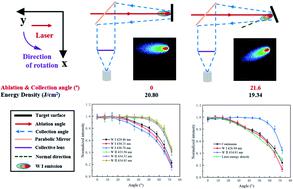当前位置:
X-MOL 学术
›
J. Anal. At. Spectrom.
›
论文详情
Our official English website, www.x-mol.net, welcomes your
feedback! (Note: you will need to create a separate account there.)
Characterization of laser-induced breakdown spectroscopy on tungsten at variable ablation angles using a coaxial system in a vacuum
Journal of Analytical Atomic Spectrometry ( IF 3.1 ) Pub Date : 2021-07-30 , DOI: 10.1039/d1ja00196e Huace Wu 1 , Cong Li 1 , Ding Wu 1 , Jiamin Liu 1 , Zhonglin He 1 , Qianhui Li 1 , Shu Yuan 1 , Xiaoqian Cui 1 , Ran Hai 1 , Hongbin Ding 1
Journal of Analytical Atomic Spectrometry ( IF 3.1 ) Pub Date : 2021-07-30 , DOI: 10.1039/d1ja00196e Huace Wu 1 , Cong Li 1 , Ding Wu 1 , Jiamin Liu 1 , Zhonglin He 1 , Qianhui Li 1 , Shu Yuan 1 , Xiaoqian Cui 1 , Ran Hai 1 , Hongbin Ding 1
Affiliation

|
As an in situ and remote diagnostic technique, laser-induced breakdown spectroscopy (LIBS) has been well proven to detect the elemental distribution on plasma-facing materials (PFMs) in the magnetic confinement nuclear fusion device of Experimental Advanced Superconducting Tokamak (EAST). However, due to the limited optical windows and irregular shape of the PFM surface, such as the monoblock structure of the divertor, the laser ablation angles (LAAs) of LIBS always vary with the laser spot scanning on the different regions of the PFMs. In this work, a LIBS system with a coaxial collection configuration based on the linear array fiber bundle is developed to investigate the features of laser-induced tungsten (W) plasma spectra at variable LAAs under vacuum conditions. The results show that the LIBS signal intensity, signal to background ratio, and signal to noise ratio of the W II line have different trends compared with W I under different LAAs. The intensities of the W I line decrease faster than those of W II with the increase of LAAs. Moreover, it is confirmed that the emission of the continuum background propagates mainly along the direction of the incident laser, while the plume of W I and W II propagates along the normal direction of the target. For the coaxial LIBS system, the results show that the plasma spectral collection area with a diameter of no less than 7 mm can minimize the spectral signal loss rate under different LAAs, no matter for W I or W II. This result will further improve the understanding of the spatial evolution of LIBS plasma at variable LAAs, to optimize and upgrade the current collection system of the in situ LIBS in the nuclear fusion device of EAST.
中文翻译:

在真空中使用同轴系统在可变烧蚀角度下表征钨的激光诱导击穿光谱
作为原位和远程诊断技术,激光诱导击穿光谱 (LIBS) 已被充分证明可以检测实验先进超导托卡马克 (EAST) 磁约束核聚变装置中面向等离子体的材料 (PFM) 上的元素分布。然而,由于 PFM 表面的有限光学窗口和不规则形状,例如偏滤器的整体结构,LIBS 的激光烧蚀角 (LAA) 总是随着在 PFM 不同区域上的激光光斑扫描而变化。在这项工作中,开发了一种基于线性阵列光纤束的具有同轴收集配置的 LIBS 系统,以研究真空条件下可变 LAA 处激光诱导钨 (W) 等离子体光谱的特征。结果表明,LIBS信号强度、信背景比、在不同的左心耳下,W II 线的信噪比与 WI 相比有不同的趋势。随着左心耳的增加,WI线的强度比WII线的强度下降得更快。此外,证实了连续谱背景的发射主要沿入射激光的方向传播,而WI和W II的羽流沿目标法线方向传播。对于同轴LIBS系统,结果表明,无论是WI还是W II,直径不小于7 mm的等离子体光谱收集区都可以最大限度地降低不同LAA下的光谱信号损失率。这一结果将进一步提高对可变 LAA LIBS 等离子体空间演化的理解,以优化和升级当前的收集系统。随着左心耳的增加,WI线的强度比WII线的强度下降得更快。此外,证实了连续谱背景的发射主要沿入射激光的方向传播,而WI和W II的羽流沿目标法线方向传播。对于同轴LIBS系统,结果表明,无论是WI还是W II,直径不小于7 mm的等离子体光谱收集区都可以最大限度地降低不同LAA下的光谱信号损失率。这一结果将进一步提高对可变 LAA LIBS 等离子体空间演化的理解,以优化和升级当前的收集系统。随着左心耳的增加,WI线的强度比WII线的强度下降得更快。此外,证实了连续谱背景的发射主要沿入射激光的方向传播,而WI和W II的羽流沿目标法线方向传播。对于同轴LIBS系统,结果表明,无论是WI还是W II,直径不小于7 mm的等离子体光谱收集区都可以最大限度地降低不同LAA下的光谱信号损失率。这一结果将进一步提高对可变 LAA LIBS 等离子体空间演化的理解,以优化和升级当前的收集系统。证实连续谱背景的发射主要沿入射激光方向传播,而WI和W II的羽流沿目标法线方向传播。对于同轴LIBS系统,结果表明,无论是WI还是W II,直径不小于7 mm的等离子体光谱收集区都可以最大限度地降低不同LAA下的光谱信号损失率。这一结果将进一步提高对可变 LAA LIBS 等离子体空间演化的理解,以优化和升级当前的收集系统。证实连续谱背景的发射主要沿入射激光方向传播,而WI和W II的羽流沿目标法线方向传播。对于同轴LIBS系统,结果表明,无论是WI还是W II,直径不小于7 mm的等离子体光谱收集区都可以最大限度地降低不同LAA下的光谱信号损失率。这一结果将进一步提高对可变 LAA LIBS 等离子体空间演化的理解,以优化和升级当前的收集系统。结果表明,无论是WI还是W II,直径不小于7 mm的等离子体光谱采集区都可以最大限度地降低不同LAA下的光谱信号丢失率。这一结果将进一步提高对可变 LAA LIBS 等离子体空间演化的理解,以优化和升级当前的收集系统。结果表明,无论是WI还是W II,直径不小于7 mm的等离子体光谱采集区都可以最大限度地降低不同LAA下的光谱信号丢失率。这一结果将进一步提高对可变 LAA LIBS 等离子体空间演化的理解,以优化和升级当前的收集系统。EAST 核聚变装置中的原位LIBS。
更新日期:2021-08-17
中文翻译:

在真空中使用同轴系统在可变烧蚀角度下表征钨的激光诱导击穿光谱
作为原位和远程诊断技术,激光诱导击穿光谱 (LIBS) 已被充分证明可以检测实验先进超导托卡马克 (EAST) 磁约束核聚变装置中面向等离子体的材料 (PFM) 上的元素分布。然而,由于 PFM 表面的有限光学窗口和不规则形状,例如偏滤器的整体结构,LIBS 的激光烧蚀角 (LAA) 总是随着在 PFM 不同区域上的激光光斑扫描而变化。在这项工作中,开发了一种基于线性阵列光纤束的具有同轴收集配置的 LIBS 系统,以研究真空条件下可变 LAA 处激光诱导钨 (W) 等离子体光谱的特征。结果表明,LIBS信号强度、信背景比、在不同的左心耳下,W II 线的信噪比与 WI 相比有不同的趋势。随着左心耳的增加,WI线的强度比WII线的强度下降得更快。此外,证实了连续谱背景的发射主要沿入射激光的方向传播,而WI和W II的羽流沿目标法线方向传播。对于同轴LIBS系统,结果表明,无论是WI还是W II,直径不小于7 mm的等离子体光谱收集区都可以最大限度地降低不同LAA下的光谱信号损失率。这一结果将进一步提高对可变 LAA LIBS 等离子体空间演化的理解,以优化和升级当前的收集系统。随着左心耳的增加,WI线的强度比WII线的强度下降得更快。此外,证实了连续谱背景的发射主要沿入射激光的方向传播,而WI和W II的羽流沿目标法线方向传播。对于同轴LIBS系统,结果表明,无论是WI还是W II,直径不小于7 mm的等离子体光谱收集区都可以最大限度地降低不同LAA下的光谱信号损失率。这一结果将进一步提高对可变 LAA LIBS 等离子体空间演化的理解,以优化和升级当前的收集系统。随着左心耳的增加,WI线的强度比WII线的强度下降得更快。此外,证实了连续谱背景的发射主要沿入射激光的方向传播,而WI和W II的羽流沿目标法线方向传播。对于同轴LIBS系统,结果表明,无论是WI还是W II,直径不小于7 mm的等离子体光谱收集区都可以最大限度地降低不同LAA下的光谱信号损失率。这一结果将进一步提高对可变 LAA LIBS 等离子体空间演化的理解,以优化和升级当前的收集系统。证实连续谱背景的发射主要沿入射激光方向传播,而WI和W II的羽流沿目标法线方向传播。对于同轴LIBS系统,结果表明,无论是WI还是W II,直径不小于7 mm的等离子体光谱收集区都可以最大限度地降低不同LAA下的光谱信号损失率。这一结果将进一步提高对可变 LAA LIBS 等离子体空间演化的理解,以优化和升级当前的收集系统。证实连续谱背景的发射主要沿入射激光方向传播,而WI和W II的羽流沿目标法线方向传播。对于同轴LIBS系统,结果表明,无论是WI还是W II,直径不小于7 mm的等离子体光谱收集区都可以最大限度地降低不同LAA下的光谱信号损失率。这一结果将进一步提高对可变 LAA LIBS 等离子体空间演化的理解,以优化和升级当前的收集系统。结果表明,无论是WI还是W II,直径不小于7 mm的等离子体光谱采集区都可以最大限度地降低不同LAA下的光谱信号丢失率。这一结果将进一步提高对可变 LAA LIBS 等离子体空间演化的理解,以优化和升级当前的收集系统。结果表明,无论是WI还是W II,直径不小于7 mm的等离子体光谱采集区都可以最大限度地降低不同LAA下的光谱信号丢失率。这一结果将进一步提高对可变 LAA LIBS 等离子体空间演化的理解,以优化和升级当前的收集系统。EAST 核聚变装置中的原位LIBS。











































 京公网安备 11010802027423号
京公网安备 11010802027423号